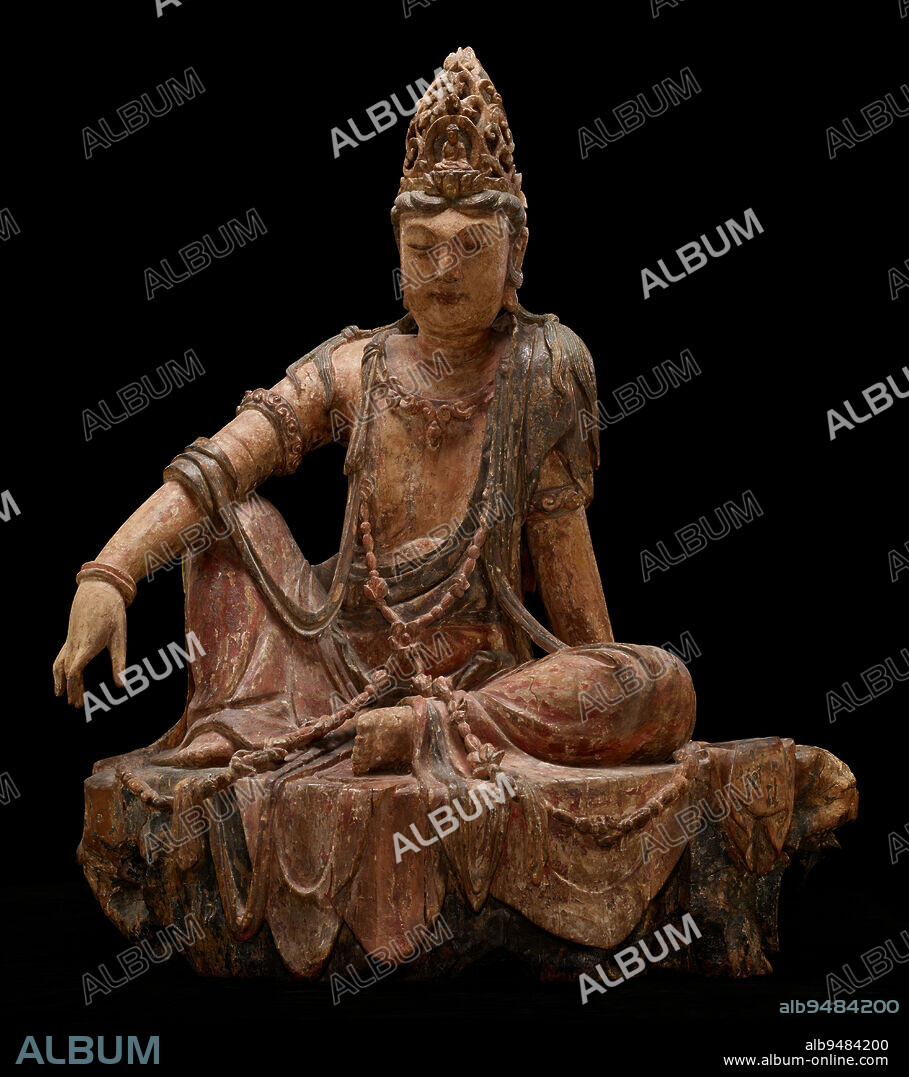alb9484200
Avalokiteshvara Bodhisattva in the Water-Moon Form (Shuiyue Guanyin), 12th century, 40 1/2 x 33 1/2 x 20in. (102.9 x 85.1 x 50.8cm), Wood, gesso and pigments, China, 12th century, Of the many manifestations of the bodhisattva Avalokiteshvara, perhaps none was more prevalent in East Asia than the uniquely Chinese form known as 'Water-Moon Avalokiteshvara,' which later also spread to Korea and Japan. This form of the bodhisattva presides over his own paradise, Potolaka, which is described in scripture as a rugged seaside cave from which Avalokiteshvara could admire the reflection of the moon in the water. Appropriately, he appears meditative and relaxed and is seated informally in the 'royal-ease' posture. Ornately dressed, with silk robes, fluttering sashes, jewelry, and an elaborate hairstyle, he also wears a headpiece that features an image of Amitbha, the buddha to whom Avalokiteshvara attends. Believers might look to a sculpture like this as a guide for their own journeys toward enlightenment.

|
Añadir a otro lightbox |
|
Añadir a otro lightbox |



¿Ya tienes cuenta? Iniciar sesión
¿No tienes cuenta? Regístrate
Compra esta imagen.
Selecciona el uso:

Descripción:
Ver traducción automática
Avalokiteshvara Bodhisattva in the Water-Moon Form (Shuiyue Guanyin), 12th century, 40 1/2 x 33 1/2 x 20in. (102.9 x 85.1 x 50.8cm), Wood, gesso and pigments, China, 12th century, Of the many manifestations of the bodhisattva Avalokiteshvara, perhaps none was more prevalent in East Asia than the uniquely Chinese form known as 'Water-Moon Avalokiteshvara,' which later also spread to Korea and Japan. This form of the bodhisattva presides over his own paradise, Potolaka, which is described in scripture as a rugged seaside cave from which Avalokiteshvara could admire the reflection of the moon in the water. Appropriately, he appears meditative and relaxed and is seated informally in the 'royal-ease' posture. Ornately dressed, with silk robes, fluttering sashes, jewelry, and an elaborate hairstyle, he also wears a headpiece that features an image of Amitbha, the buddha to whom Avalokiteshvara attends. Believers might look to a sculpture like this as a guide for their own journeys toward enlightenment.
Crédito:
Album / quintlox
Autorizaciones:
Modelo: No - Propiedad: No
¿Preguntas relacionadas con los derechos?
¿Preguntas relacionadas con los derechos?
Tamaño imagen:
5102 x 5749 px | 83.9 MB
Tamaño impresión:
43.2 x 48.7 cm | 17.0 x 19.2 in (300 dpi)
 Pinterest
Pinterest Twitter
Twitter Facebook
Facebook Copiar enlace
Copiar enlace Email
Email
